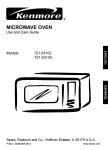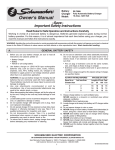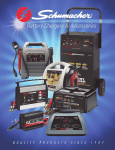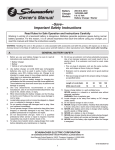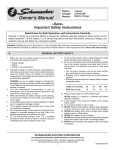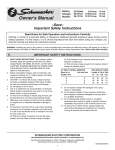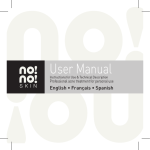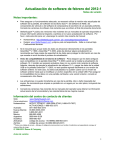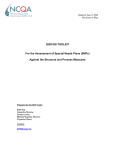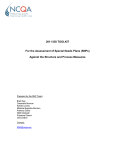Download Schumacher Electric SF-1252MA Operating instructions
Transcript
ELECTRIC CORP. 801 BUSINESS CENTER DRIVE • MOUNT PROSPECT, IL 60056-2179 • 800-621-5485 Send Warranty Product Repairs to: 1025 E. Thompson Avenue, Hoopeston, IL 60942-0280 Call Customer Service if you have questions: 1-800-621-5485 A. IMPORTANT SAFETY INSTRUCTIONS SAVE THESE INSTRUCTIONS 1. - This manual contains important safety and operating instructions for battery charger Model SE-1252MA and SE-3005 which is to be used with 12 volt lead acid battery only. A BATTERY CHARGER RECEIVES AC POWER FROM THE ELECTRIC OUTLET AND DELIVERS DC CURRENT TO THE BATTERY. 2. Before using battery charger, read all instructions and cautionary markings on (1) battery charger, (2) battery and (3) product using battery. 3. CAUTION - To reduce risk of injury, charge only lead acid type rechargeable batteries. Other types of batteries may burst causing personal injury and damage. 4. Use of an attachment not recommended or sold by the battery charger manufacturer may result in a risk of fire, electric shock, or injury to persons. 5. To reduce risk of damage to electric plug and cord, pull by plug rather than cord when disconnecting charger. 6. Make sure cord is located so that it will not be stepped on, tripped over, or otherwise subjected to damage or stress. 7. An extension cord should not be used unless absolutely necessary. Use of improper extension cord could result in a risk of fire and electric shock. If extension cord must be used, make sure: (a) That pins on plug of extension cord are the same number, size and shape as those of plug on charger. (b) That extension cord is properly wired and in good electrical condition; and that wire size is as specified below: Length of cord (feet): 25 50 100 150 AWG size of cord: 16 14 10 8 8. Do not operate charger with damaged cord or plug - replace them immediately. 9. Do not operate charger if it has received a sharp blow, been dropped, or otherwise damaged in any way; take it to a qualified service man. 10. Do not disassemble charger; take it to a qualified serviceman when service or repair is required. Incorrect reassembly may result in a risk of electric shock or fire. 11. To reduce risk of electric shock, unplug charger from outlet before attempting any maintenance or cleaning. Turning off controls will not reduce this risk. B. WARNING - RISK OF EXPLOSIVE GASES 1. WORKING IN VICINITY OF A LEAD-ACID BATTERY IS DANGEROUS. BATTERIES GENERATE EXPLOSIVE GASES DURING NORMAL BATTERY OPERATION. FOR THIS REASON, IT IS OF UTMOST IMPORTANCE THAT EACH TIME BEFORE USING YOUR CHARGER, YOU READ THIS MANUAL AND FOLLOW THE INSTRUCTION EXACTLY. 00-00-000532/0103 1 2. To reduce risk of battery explosion, follow these instructions and those published by battery manufacturer and manufacturer of any equipment you intend to use in vicinity of battery. Review cautionary marking on these products and on engine. C. PERSONAL PRECAUTIONS - USE SAFETY GLASSES 1. Someone should be within range of your voice or close enough to come to your aid when you work near a lead-acid battery. 2. Have plenty of fresh water and soap nearby FOR USE IF battery acid contacts skin, clothing or eyes. 3. Wear complete eye protection and clothing protection. Avoid touching eyes while working near battery. 4. If battery acid contacts skin or clothing, wash immediately with soap and water. If acid enters eye, immediately flood eye with running cold water for at least 10 minutes and get medical attention immediately. 5. NEVER smoke or allow a spark or name in vicinity of bakery or engine. 6. Be extra cautious not to drop a metal tool onto battery. It might spark or short-circuit battery or other electrical part that may cause explosion. 7. Remove personal metal items such as rings, bracelets, necklaces, and watches when working with a lead acid battery. A lead-acid battery can produce a short-circuit current high enough to weld a ring or the like to metal, causing a severe burn. 8. Use charger for charging a LEAD-ACID battery only. It is not intended to supply power to a low voltage electrical system other than in an automotive application. Do not use battery charger for charging dry-cell batteries that are commonly used with home appliances. These batteries may burst and cause injury to persons and damage to property. 9. NEVER charge a frozen battery. 10. WARNING: Handling the cord on this product or cords associated with accessories sold with this product, will expose you to lead, a chemical known to the State of California to cause cancer and birth defects or other reproductive harm. Wash hands after handling. D. PREPARING TO CHARGE 1. If necessary to remove battery from vehicle to charge, always remove grounded terminal from battery first. Make sure all accessories in the vehicle are off, so as not to cause an arc. 2. Be sure area around battery is well ventilated while battery is being charged. Gas can be forcefully blown away by using a piece of cardboard or other non-metallic material as a fan. 3. Clean battery terminals. Be careful to keep corrosion from coming in contact with eyes. 4. Add distilled water in each cell until battery acid reaches level specified by battery manufacturer. This helps purge excessive gas from cells. Do not over fill. For a battery without cell caps, carefully follow manufacturer’s recharging instructions. 5. Study all battery manufacturer’s specific precautions, such as removing or not removing cell caps while charging, and recommended rates of charge. E. CHARGER LOCATION 1. Locate charger as far away from battery as DC cables permit. 2. Never place charger directly above battery being charged; gases from battery will corrode and damage charger. 3. Never allow battery acid to drip on charger when reading specific gravity or filling battery. 2 4. Do not operate charger in a closed-in area or restrict ventilation in any way. 5. Do not set a battery on top of charger. 6. Do not expose charger to rain or snow. F. DC CONNECTION PRECAUTIONS 1. Connect and disconnect DC output clips only after removing AC cord from electric outlet. Never allow clips to touch each other. Attach clips to battery posts and twist or rock back and forth several times to make a good connection. This tends to keep clips from slipping off terminals and helps to reduce risk of sparking. G. FOLLOW THESE STEPS WHEN BATTERY IS INSTALLED IN VEHICLE. A SPARK NEAR BATTERY MAY CAUSE BATTERY EXPLOSION. TO REDUCE RISK OF SPARK NEAR BATTERY, DO AS FOLLOWS: 1. Position AC and DC cords to reduce risk of damage by hood, door, or moving engine parts. 2. Stay clear of fan blades, belts, pulleys and other parts that can cause injury to persons. 3. Check polarity of battery posts. POSITIVE (POS, P. +) battery post usually has larger diameter NEGATIVE (NEG, N. -) post. 4. Determine which post of battery is grounded (connected to the chassis). If negative post is grounded to chassis (as in most vehicles), see #5. If positive post is grounded to the chassis, see #6. 5. For negative-grounded vehicle, connect POSITIVE (RED) clip from battery charger to POSITIVE (POS, P. +) ungrounded post of battery. Connect NEGATIVE (BLACK) clip to vehicle chassis or engine block away from battery. Do not connect clip to carburetor, fuel lines, or sheet-metal body parts. Connect to a heavy gage metal part of the frame or engine block. 6. For positive-grounded vehicle, connect NEGATIVE (BLACK) clip from battery charger to NEGATIVE (NEG, N. -) ungrounded post of battery. Connect POSITIVE (RED) clip to vehicle chassis or engine block away from battery. Do not connect clip to carburetor, fuel lines, or sheet-metal body parts. Connect to a heavy gage metal part of the frame or engine block. 7. When disconnecting charger, disconnect AC cord, remove clip from vehicle chassis, and then remove clip from battery terminal, in that order. 8. See operating instructions for length of charge information. H. FOLLOW THESE STEPS WHEN BATTERY IS OUTSIDE VEHICLE. A SPARK NEAR THE BATTERY MAY CAUSE BATTERY EXPLOSION. TO REDUCE RISK OF A SPARK NEAR BATTERY, DO AS FOLLOWS: 1. Check polarity of battery posts. POSITIVE (POS, P. +) battery post usually has a larger diameter than NEGATIVE (NEG, N. -) post. 2. Attach at least a 24-inch-long 6-gauge (AWG) insulated battery cable to NEGATIVE (NEG, N. -) battery post. 3. Connect POSITIVE (RED) charger clip to POSITIVE (POS, P. +) post of battery. 4. Position yourself and free end of cable as far away from battery as possible then connect NEGATIVE (BLACK) charger clip to free end of cable. 5. Do not face battery when making final connection. 6. When disconnecting charger, always do so in reverse sequence of connecting procedure and break first connection while as far away from battery as practical. 3 7. A marine (boat) battery must be removed and charged on shore. To charge It on board requires equipment specially designed for marine use. I. GROUNDING AND AC POWER CORD CONNECTION INSTRUCTIONS Charger should be grounded to reduce risk of electric shock. Charger is equipped with an electric cord having an equipment grounding conductor and a grounding plug. The plug must be plugged into an outlet that is properly installed and grounded in accordance with all local codes and ordinances. DANGER - Never alter AC cord or plug provided - if it will not fit outlet, have proper outlet installed by a qualified electrician. Improper connection can result in a risk of an electric shock. This battery charger is for use on a nominal 12-volt circuit, and has a grounding plug that looks like the plug illustrated in sketch A in Figure 1. A temporary adapter, which looks like the adapter illustrated in sketches B and C, may be used to connect this plug to a two pole receptacle as shown in sketch B if a properly grounded outlet is not available. The temporary adapter should be used only until a properly grounded outlet can be installed by a qualified electrician. DANGER - Before using adapter as illustrated, be certain that center screw of outlet plate is grounded. The green-colored rigid ear or lug extending from adapter must be connected to a properly grounded outlet - make certain it is grounded. If necessary, replace original outlet cover plate screw with a longer screw that will secure adapter ear or lug to outlet cover plate and make ground connection to grounded outlet. FIGURE 1 GROUNDING METHODS J. OUTPUT CURRENT SELECTOR SWITCH 2 Amp position - may be used for any size battery larger than 10 Ampere hours (AH). This position is primarily intended for charging batteries between 10 and 30 AH. These are the types typically used in motor cycles and garden tractors. 10 Amp position - may be used for batteries larger than 30 AH. If used on smaller batteries, gassing, loss of liquid and over heating may occur. Start position - will assist the battery with up to an additionally 50 Amp while cranking the engine. This is an intermittent use position and should be limited to a MAXIMUM of 10 seconds on, followed by a MINIMUM of 3 minutes off. For the off period you may switch to either the 2 or 10 Amp position or disconnect from the AC power source. Applications drawing more than 50 Amps may automatically interrupt the output circuit breaker in less than 10 seconds. Do not use this position for charging a battery. Doing so will cause a safety protector to shut down all functions after 2 minutes of use and remain so for 15 to 20 minutes before resetting. For best results charge the battery for 10 minutes in the 10 Amp position before cranking the engine. 4 K. BATTERY TYPE SELECTOR SWITCH This two position switch groups Deep Cycle and Maintenance Free batteries together In one position and conventional type batteries in the other position. The conventional setting regulates the charge voltage at 13.8 +/-.2 volts while the Deep Cycle regulates at 14.2 +/ -.2 volts. Some battery manufacturers do not recommend using the Deep Cycle setting their batteries. This is usually, but not always indicated on the battery, check with the manufacturer. Never use the Deep Cycle setting on conventional type batteries, over charging may occur. L. AUTOMATIC FEATURES When a battery approaches the full charge state, charge current will begin to cycle on and off every few seconds as indicated by the Ammeter. As the battery continues to charge, off time will increase. In the convention position, off time may reach 30 minutes with an on time of only a few seconds. Off time for the deep cycle position is somewhat shorter. Time will vary depending on bakttery size and condition. No sparks should occur when the battery clips come together or when connected to a battery, even if connected in reverse polarity. Charge current will only flow when properly connected and after a 3 to 5 seconds delay. The charger will not respond to a battery so depleted of charge that its terminal voltage is less than 3 volts. M. AMP METER 1. This gauge indicates the amount of charge current drawn from the charger by the battery. The battery will draw less current as it approaches the full charge state. N. BATTERY CHARGING 1. Review section D. 2. Before making any connections to the charger, set battery type switch and charge rate switch to the appropriate nettings. Then connect to a 12 bolt battery as outlined in section G. Then plug AC power cord into a 120V AC outlet. CHARGE PERIOD The time required to bring a battery to the full charge state depends on battery size in Ampere hours (AH), amount of charge in the battery and the Ampere rate the battery is being recharged at. In using this chart, first locate battery size in AH. Recharge time is located below the intersection of battery size and the diagonal lines representing percent of charge in the battery. Chart is based on a 10 Amp charge rate, for a 2 Amp charge multiply charging time by 5. 25 50 75 % % 100 BATTERY SIZE (Ah) O. 80 60 40 F %O ATT NB 0% Y ER EI RG A CH % 20 6 3 9 TIME TO REACH FULL CHARGE ( HOURS) 5 12 P. INDICATION OF A FULLY CHARGED BATTERY ARE: 1. When meter pointer rest on 0 Amp with an occasional pulse up scale. 2. A hydrometer reading of the battery’s electrolyte indicates 1.250 to 1.285. 3. When a battery reaches 80 to 85% of full charge, bubbles will appear on the surface of the fluid. Due to the automatic features of the charger bubbles should not become more vigorous, if they do, discontinue charging. Q. PROBLEM CHECKLIST 1. If no meter reading, check the following: (a) Remove the plug from the AC outlet and recheck the battery charger clips for clean, tight connections. (b) Check for voltage at the AC outlet by plugging in a lamp or other appliance. 2. If test pointer moves to extreme right, remains a short time and is accompanied by a clicking sound, check the following: (a) A severely discharged, but otherwise good battery. In this situation, the circuit breaker will continue to cycle and the test pointer will swing from one side to the other until the battery has recovered sufficiently to allow a normal charging rate. (b) A defective battery may cause repeated circuit breaker cycling. A battery in this condition will not accept a charge and should be replaced. LIMITED WARRANTY SCHUMACHER ELECTRIC CORPORATION, 801 BUSINESS CENTER DRIVE, MT. PROSPECT, ILLINOIS 60056-2179 MAKES THIS LIMITED WARRANTY TO THE ORIGINAL PURCHASER AT RETAIL OF THIS PRODUCT. THIS LIMITED WARRANTY IS NOT TRANSFERABLE. Schumacher Electric Corporation warrants this battery charger for two years from date of purchase at retail against defective material or workmanship. If such should occur, the unit will be repaired or replaced at the option of the manufacturer It is the obligation of the purchaser to forward the unit together with proof of purchase, transportation and/ or mailing charges prepaid to the manufacturer or its authorized representative. This limited warranty is void if the product is misused, subjected to careless handling, or repaired by anyone other than the manufacturer or its authorized representative. The manufacturer makes no warranty other then this limited warranty and expressly excludes any implied warranty including any warranty for consequential damages. THIS IS THE ONLY EXPRESS LIMITED WARRANTY AND THE MANUFACTURER NEITHER ASSUMES NOR AUTHORIZES ANYONE TO ASSUME OR MAKE ANY OTHER OBLIGATION TOWARDS THE PRODUCT OTHER THAN THIS EXPRESS LIMITED WARRANTY. THE MANUFACTURER MAKES NO WARRANTY OF MERCHANTABILITY OR FITNESS FOR PURPOSE OF THIS PRODUCT AND EXPRESSLY EXCLUDES SUCH FROM THIS LIMITED WARRANTY. SOME STATES DO NOT ALLOW THE EXCLUSION OR LIMITATION OF INCIDENTAL OR CONSEQUENTIAL DAMAGES OR LENGTH OF IMPLIED WARRANTY SO THE ABOVE LIMITATIONS OR EXCLUSIONS MAY NOT APPLY TO YOU. THIS WARRANTY GIVES YOU SPECIFIC LEGAL RIGHTS AND YOU MAY ALSO HAVE OTHER RIGHTS WHICH VARY FROM STATE TO STATE. 6 ELECTRIC CORP. 801 BUSINESS CENTER DRIVE • MOUNT PROSPECT, IL 60056-2179 • 800-621-5485 Para reparación del producto bajo garantía, envíelo a: 1025 E. Thompson Avenue, Hoopeston, IL 609420280. Para más información comuníquese al Dep. de Servicios al Cliente: 1-800-621-5485 A. INSTRUCCIONES IMPORTANTES DE SEGURIDAD: 1. GUARDAR ESTAS INSTRUCCIONES de este manual, el cual contiene todas las instrucciones necesarias para trabajar estos cargadores de baterías. Para los Modelos: SE-1252MA y SE-3005 que es para usar en en 12-voltios plomo ácido batería solamente. UN CARGADOR DE BATERIAS RECIBE POTENCIA (CORRIENTE ALTERNA (AC) EL TOMA-CORRIENTE ELÉCTRICO Y LA ENTREGA DE ESA CORRIENTE SERA EN FORMA DE CORRIENTE DIRECTA (DC) QUE ES LA QUE VA HACIA LA BATERIA DEL CARRO. 2. Antes de usar su cargador de baterías lea todas las instrucciones y letreros de precaución (1) en el cargador, (2) en la batería, y (3) producto usando la batería. 3. PRECAUCION: Para reducir los riesgos de daños, cargue solamente la batería del tipo de plomo ácido y recargable. Otros tipos de baterías pueden explotar y causarles daños físicos. 4. Si usan algún equipo que no sea recomendado o vendido por el fabricante, puede producir un fuego o sacudida eléctrica o daños físicos a la persona que lo use. 5. Para reducir el riesgo de daños hacia el cordón y toma-corriente cuando vayan a desconectar ese cordón de toma-corriente no jalen el cordón sino jalen el enchufe, esto es cuando vayan a desconectar el cargador de baterías del enchufe de la corriente. 6. Tengan cuidado donde guardan el cordón, no deje que ninguna persona camine sobre el mismo, lo jale o lo dañe. 7. No usar cables de extensión a no ser que sea absolutamente necesario. El uso de una extensión inapropiada, puede resultaren que el cable es muy largo y muy fino al subir el amperaje puede haber fuego o sacudida eléctrica. Si tienen que usar alguna extensión asegúrense de lo siguiente: (a) Que los ganchos del enchufe sean del mismo número, tamaño y figura que los del cargador. (b) Que la extensión esté en buenas condiciones. AMAÑO DEL CORDÓN EN PIES 25 50 100 150 GRUESO O CALIBRE DEL CORDÓN EL 16 14 10 8 8. No opere el cargador con un cordón dañado, cámbielo inmediatamente. 9. No use el cargador si ha recibido un golpe fuerte, o si se le ha caído o dañado en cualquier forma; llevarlo a un taller para que lo reparen y que sea un técnico que conozca de estos productos, para que le hagan un buen trabajo en la batería. 10. No desarmar el cargador, llevarlo a un taller de técnicos capacitados que conozca estos equipos. Si lo instala mal puede causar fuego o sacudida eléctrica. 11. Para reducir los riesgos de sacudidas eléctricas desconecte el cargador del tomacorriente, antes de intentar limpiarlo. Apagar los controles no es suficiente para prevenir los daños. Pagina 1 B. ADVERTENCIA - RIESGOS CON GASES EXPLOSIVOS 1. Trabajar en su vecindario con una batería de plomo ácido es muy peligroso. Estas baterías generan gases explosivos durante su trabajo normal. Por esta razón es muy importante que antes de usar el cargador, lean el manual y sigan las instrucciones exactas. 2. Para reducir los riesgos de explosión siga estas instrucciones y las instrucciones que fabricante de baterías y cualquier otro equipo que vayan usar. Repasen los mensajes de prevención en estos equipos. C. PRECAUCIONES PERSONALES 1. Debe estar alguien cerca o al alcance suyo cuando trabaje en una de estas baterías (de plomo ácido). 2. Tenga agua fresca con jabón cerca por si acaso le cae el ácido en la piel, en la ropa, o en los ojos. 3. Use el protector completo para protegerse los ojos y la ropa. Evite tocarse los ojos cuando esté trabajando cerca de las baterías (de plomo ácido). 4. Si cayese ácido en la piel o en la ropa, lávelo inmediatamente con jabón y agua. Si el ácido le cae en los ojos, enjuáguese inmediatamente con agua fría por unos 10 minutos o más, luego llame al Doctor o busque asistencia médica. 5. Nunca fume, ni encienda una llama cerca de la batería o del motor de su carro. 6. Tenga cuidado de no dejar caer herramienta de metálica encima de la batería, este puede causar un corto circuito y explotar la batería. 7. Quítese todos los metales personales, tales como anillos, brazaletes, collares, relojes, mientras este trabajando con una batería. Una batería de plomo ácido puede producir un corto circuito tan alto como para soldar un anillo de metal y causarle una quemadura muy grave. 8. Use el cargador para cargar una batería de plomo ácido, no sirve para ningún otro tipo de equipo de voltaje pequeño, sólo para el automóvil. No use el cargador para baterías caseras porque explotan. 9. Nunca cargue una batería que esté congelada. 10. ADVERTENCIA - El manejo del cordón en este producto, o de los cordones asociados con los accesorios vendidos con este producto, le expone a usted al plomo, un producto químico conocido en el Estado de California de causar cáncer y defectos de nacimiento u otros daños reproductivos. Lávese las manos después de manejar estos cordones. D. PREPARATIVOS PARA CARGAR 1. Si tiene que quitar la batería del carro para darle carga; (1) siempre quite el terminal que hace tierra, (2) asegúrese que todos los accesorios del carro estén apagados. 2. Asegúrese que el área donde esté cargando la batería,esté bien ventilada mientras que está dando carga. El gas se puede eliminar con un cartón y usándolo como abanico. 3. Limpie los terminales de la batería, cuidando que no le caiga ninguna substancia corrosiva en los ojos. 4. Añadan agua destilada a las células de la batería hasta el nivel que el fabricante especifica. Esto le ayuda a botar el gas excesivo de las células. No la sobre llene. Para baterías sin tapa siga las instrucciones de dar carga cuidadosamente. 5. Estudie todas las precauciones que el fabricante les especifica mientras que carga la batería. También la proporción de carga que debe darle. E. POSICION DEL CARGADOR 1. Coloque el cargador lejos de la batería. Lo más lejos que permita el cable. Pagina 2 2. Nunca sitúe el cargador directamente encima de la batería, cuando la cargue. Los gases de la batería dañarán el cargador. 3. Nunca permita que el ácido de la batería, gotee sobre el cargador cuando llene la batería y pueda caer por gravedad sobre la misma. 4. No opere el cargador en un área cerrada restringida de ventilación. 5. No coloque la batería sobre el cargador. 6. No deje que le caiga lluvia ni nieve al cargador. F. PRECAUCIONES PARA CONECCION DE CORRIENTE DIRECTA (DC) 1. Conecte y desconecte los clips de salida de corriente DC del acumulador, únicamente después de haber apagado los interruptores y haber removido el cordón de corriente AC del toma-corriente, nunca permita que se toquen los dos terminales. 2. Una los terminales a los postes de la batería y enrósquelos varias veces para tener una buena conección. Esto previene que se salgan los terminales de los clips de la batería y reduce los riesgos de chispa. G. SIGA LOS PASOS CUANDO INSTALE LA BATERIA EN EL CARRO. UNA CHISPA CERCA DE LA BATERIA PUEDE CAUSAR UNA EXPLOSION. PARA REDUCIR LOS RIESGOS DE LA CHISPA CERCA DE LA BATERIA HAGA LO SIGUIENTE: 1. Sitúe los cordones de corriente AC y DC. Para reducir riesgo de danó por gancho puerta o movimiento por parte del motor. 2. Manténgase lejos de las paletas de un ventilador, correas u otras piezas que puedan causarle daño a las personas. 3. Chequee la polaridad de los postes de la batería, ya que toda batería tiene dos postes, uno positivo y el otro negativo señalado como signo + o signo - . Casi siempre tienen un diámetro más grande los positivos que los negativos. 4. Determine cuál de los postes es el que hace tierra y que van conectados al chasis del carro. Si el poste negativo hace tierra con el chasis (Como en casi todos los automóviles, siga las instrucciones del No. 5). Si el poste positivo (+) hace tierra con el chasis, siga las instrucciones del No. 6. 5. Para vehículos con tierra negativa (-), conecte la tenaza (+) positiva roja al poste positivo (+) sin tierra de la batería. Conecte la clip del cable negativo negro al chasis del carro o motor lejos de la batería. No conecte las alicates al carburador, lineas de gasolina u hojas de metal del cuerpo del carro. Conecte un metal fuerte del marco del bloque del motor. 6. Para vehículos que tienen tierra positivo (+), conecte los alicates (-) negativo negro del cargador al poste negativo de la batería. Conecte los alicates positivo (+) rojo al chasis del vehículo o al bloque del motor lejos de la batería. No conecte este alicate del cargador al carburador, lineas de gasolina u hojas de metal del carro. Conecte solamente al marco de metal grueso del bloque del motor. 7. Cuando vaya a desconectar el cargador ponga los interruptores en la posición OFF desconecte el cordón de la corriente AC del toma-corriente y después quite los alicates del chasis y de la batería en este mismo orden. 8. Observe las instrucciones de trabajo para información sobre el tiempo de carga. H. SIGA ESTOS PASOS CUANDO LA BATERIA ESTE FUERA DEL VEHICULO. CUANDO LA BATERIA ESTA SITUADA FUERA DEL VEHICULO: 1. Compruebe la polaridad de los postes de la batería. El poste positivo generalmente tiene un diámetro más grande que el poste negativo. Si no son identificados como (+) (-). 2. Adjunte un cable de batería aislado por lo menos de 24" de largo y de calibre 6 al poste negativo. Pagina 3 3. Conecte el alicate del cargador positivo rojo al poste positivo de la batería. 4. Sitúese usted y la parte libre del cable lo más lejos posible de la batería, entonces conecte el poste del cargador negativo negro al extremo libre del cable. 5. No se acerque a la batería cuando haga la conexión final. 6. Cuando desconecte el cargador siempre hágalo en secuencia reversa en la forma que lo conectó, yendo desde el paso final hasta el paso inicial, y cuando desconecte la primera conexión hágalo lo más lejos posible de la batería. 7. Una batería marina tiene que quitarse y cargarse en la tierra. Para cargarla en el barco lleva un equipo especial para uso marítimo. I. INSTRUCCIONES DE TIERRA Y CONEXION DEL CORDON DE CORRIENTE ALTERNA DEL TOMA-CORRIENTE: El cargador debe tener tierra para reducir los riesgos de shocks eléctricos. El cargador está equipado con un cordón eléctrico que tiene un conductor de tierra para los equipos y un interruptor que tiene la tierra también. Este interruptor se conecta a un toma-corriente que esté bien instalado y que tenga tierra. PELIGRO - Nunca altere el cable o interruptor que viene con el equipo. Si ese tomacorriente no cabe en el toma-corriente instalado en el lugar donde usted quiera cargar el cargador de baterías, tiene que usar una conexión especial, tal y como se muestra en las esas instrucciones. Este cargador de baterías para usarlo en un circuito de 120 -60 HZ voltios, tiene un interruptor con tierra que luce como el de la ilustración A de estas instrucciones. Un adaptador temporal que luce como el B y C, puede usarse para conectar el interruptor a un toma-corriente de dos polos como el de la letra B, si no tiene un toma-corriente con tierra. El adaptador temporal debe de usarse siempre hasta que puedan instalar en su lugar un toma-corriente con tierra de tres tomas. PELIGRO - Antes de usar el adaptador asegúrese que el tornillo del centro del tomacorriente haga tierra. El taco verde que sobresale del adaptador debe conectarse a un toma-corriente que haga tierra. Asegúrese que haga tierra y para asegurarse cambie la tapa original del toma-corriente y póngalo con un tornillo más largo para asegurar que el taco o el terminal del adaptador al toma-corriente haga tierra con el toma-corriente. FIGURA NO. 1 – MÉTODO DE CREAR TIERRA Pagina 4 J. INTERRUPTOR PARA SELECCIONAR AL RENDIMIENTO DE CORRIENTE La Posición 2 Amp—puede ser usado por cualquier batería mas grande que 10 Amperio hora (Ah). Esta posición es intentada primariamente por dar carga a baterías entre 10 y 30 Ah. Estasson baterías usados regularmente en bicimotos y tractores de jardín. La Posición 10 Amp puede ser usado por baterías mas grandes que 30 Ah. Si lo usa en baterías mas pequeñas, producir gas, perdida de liquido y acalorar pueden ocurrir. La Posición “Start” (Encender) asiste a la batería hasta 50 Amp adicional mientras que dar manivela al motor. Esta posición debe ser usada intermitente, limitada a máximo de 10 segundos encender, seguido por mínimo de tres minutos apagado. Por el tiempo apagado ponga el interruptor en posición de 2 o 10 Amp o desconecte del AC tomo corriente. Cuando le pone mas de 50 Amp, pueda interrumpe automáticamente la cortacircuitos rendimientos en menos de 10 segundos. No use esta posición para dar carga a baterías. Al hacerlo le causa al protector de seguridad que apague todas las funciones después de 2 minutos de uso y se queda así por 15 o 20 minutos antes que se ponga de nuevo. Para mejor resultados da carga a la batería por 10 minutos en posición de 10 Amps antes de que arrancar al motor. K. INTERRUPTOR SELECTOR DE TIPO DE BATERÍA Esto interruptor de dos posiciones agrupa Ciclo Hondo y Libre de Mantenimiento baterías juntos en una posición, y baterías convencional en la otra posición. La posición convencional arregla el voltaje de carga a 13.8 +/- .2 voltios. La posición Ciclo Hondo arregla a 14.2 +/ - .2 voltios. Unos fabricantes no recomiendan que usar la posición Ciclo Hondo con sus baterías. Esto es usualmente, pero no siempre, indicado en la batería. Verifique con el fabricante. Nunca use la posición Ciclo Hondo en batería convencional, porque puede dar carga demasiada. L. FUNCIONES AUTOMÁTICAS Cuando la batería se acerca al carga completa, corriente de carga se pone en ciclo encender/apagar cada cuantos segundos a como indicada por el amperímetro. A como la batería continúe la carga,el tiempo apagado aumenta. En la posición convencional, el tiempo apagado pueda que legue a 30 minutos y el tiempo encender no mas de unos segundos. En la posición Ciclo Hondo, el tiempo apagar es mas corto. Los tiempos varia depende en tamaño o condición de la batería. No deben saltar chispas cuando las grapas de la batería se juntan o sean conectadas a la batería, aunque hallan conectadas en polaridad revés. La corriente de carga pasa solamente cuando están conectadas apropiado y después de 3 o 5 segundos retraso. El cargador no responde a una batería vaciada en carga hasta que el voltaje terminal esta menos de 3 voltios. M. AMP METRO Este medidor indica la cantidad de corriente de carga que sale del cargador a la batería. La batería vaciara menos corriente de carga cuando se acerca a su carga completa. N. DANDO CARGO A LA BATERÍA 1. Repase la sección D. 2. Antes de hacer cualquier conexiones a cargado, ponga el interruptor de tipo de batería y el interruptor de medida de carga en posiciones apropiadas. Después conecte a batería de 12 voltios a como esta delineado en la sección G. Después conecte el cable AC en un 120v AC salida electricé. Pagina 5 O. Tiempo de Carga El tiempo requerido para traer una batería al carga completa depende en tamaño de batería en Amperio horas (Ah), la cantidad de carga en la batería, y la medida de Amperio que le va a dar a la batería. En usar esto gráfico, primero halle el tamaño de la batería en Ah. El tiempo para dar carga esta debajo de la intersección del tamaño de batería y lineas diagonal representando el porcentaje de carga en la batería. P. 75 % TAMANO DE BATERIA (Ah) El gráfico esta a base de 10 Amp medido de carga. Por una carga de 2 Amp, multiplique el tiempo de carga por 5. % 25 % 50 3 6 0% 9 12 INDICACIONES DE UNA BATERÍA EN ESTADO DE CARGA COMPLETA SON: 1. Cuando la aguja del medidor apunta a 0 Amp con un pulso ocasional en la dirección +. 2. El hidrómetro indica que el electrolito de la batería es 1.250 a 1.285. 3. Cuando la batería llega a 80 o 85% de carga completa, burbujas aparecen arriba del liquido. A causa de funciones automáticas del cargador, los burbujas no deben de hervir demasiado. Si lo hacen, discontinúe la carga. Q. LISTA DE PROBLEMAS 1. Si el medidor no marca, verifique lo siguiente: (a) Desconecte el cable del enchufe AC y investigue si las grapas están limpias y apretadas bien. (b) Investigue si hay voltaje en la toma-corriente por conectar lampara o utensilio en tomacorriente. 2. Si la aguja se mueve extremo a la derecha, y se detiene por un corto tiempo, y el acompasando con golpe seco, investigue lo siguiente: (a) Una batería descarga severa, pero buena de otra manera—en esta situación el cortocircuito continua ir en ciclos y la aguja se moverá de un lado al otra hasta que la batería se recupere suficiente que permite en medido de carga normal. (b) Una batería defectuosa puede causar ir en ciclos repetidamente del cortocircuito. Una batería en esta condición no acepta la carga y debe de remplazar la batería. Pagina 6













